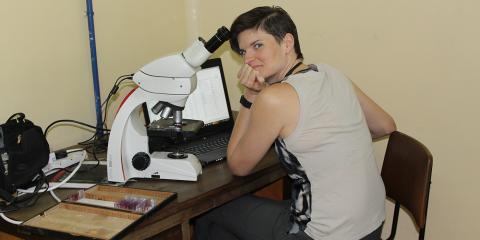News Archive
Filter By
- Abyssinian ground hornbill
- Addax
- Aldabra tortoise
- Allen's swamp monkey
- Alpaca
- American alligator
- American avocet
- American bison
- American flamingo
- American wigeon
- Andean bear
- Aquatic caecilian
- Arapaima
- Asian elephant
- Asian small-clawed otter
- Asian water dragon
- Australian snake-necked turtle
- Bald eagle
- Baltimore oriole
- Barred owl
- Beaver
- Bennett's wallaby
- Binturong
- Black-and-white ruffed lemur
- Black-and-white warbler
- Black-crowned night heron
- Black-footed ferret
- Black-tailed prairie dog
- Black-throated blue warbler
- Blue-billed curassow
- Blue crane
- Bobcat
- Brown pelican
- Bufflehead
- California sea lion
- Canvasback
- Cedar waxwing
- Channel catfish
- Cheetah
- Chicken
- Chinese alligator
- Chinese three-striped box turtle
- Clouded leopard
- Collared brown lemur
- Common raven
- Common yellowthroat
- Corals and sea anemones (anthozoa)
- Cow
- Crocodile monitor
- Cuban crocodile
- Dama gazelle
- Degu
- Dunlin
- Eastern indigo snake
- Eastern newt
- Eastern red-backed salamander
- Eastern screech-owl
- Eld's deer
- Electric eel
- Emperor newt
- Emperor tamarin
- Fennec fox
- Fishing cat
- Gaboon viper
- Geoffroy's marmoset
- Gharial
- Giant leaf-tailed gecko
- Giant panda
- Goat
- Golden-headed lion tamarin
- Golden lion tamarin
- Gray seal
- Gray wolf
- Green tree python
- Grevy's zebra
- Guam kingfisher (sihek)
- Guam rail (ko’ko’)
- Guinea pig
- Harbor seal
- Hartmann's mountain zebra
- Hawk-headed parrot
- Hellbender
- Home's hinge-back tortoise
- Hooded crane
- Iranian fat-tailed gecko
- Japanese giant salamander
- King vulture
- Komodo dragon
- Kori bustard
- Kunekune pig
- Land hermit crab
- Larger Malay mouse-deer
- Lemur leaf frog
- Lesser kudu
- Lesser Madagascar hedgehog tenrec
- Linné's two-toed sloth
- Lion
- Loggerhead shrike
- Long-tailed chinchilla
- Maned wolf
- Meerkat
- Miniature donkey
- Naked mole-rat
- North American porcupine
- North American river otter
- Northern Luzon giant cloud rat
- Northern pintail
- Northern red salamander
- Northern snakehead fish
- Northern tree shrew
- North Island brown kiwi
- Norway rat
- Orangutan
- Orchard oriole
- Ossabaw Island hog
- Ostrich
- Ovenbird
- Pallas's cat
- Panamanian golden frog
- Patagonian mara
- Persian onager
- Philippine crocodile
- Prehensile-tailed porcupine
- Prevost's squirrel
- Przewalski's horse
- Pygmy slow loris
- Red-crowned crane
- Red-fronted lemur
- Red-rumped agouti
- Red-winged blackbird
- Red knot
- Red panda
- Red River hog
- Red ruffed lemur
- Red wolf
- Ring-tailed lemur
- Ruddy duck
- Schmidt's red-tailed monkey
- Scimitar-horned oryx
- Screaming hairy armadillo
- Semipalmated plover
- Semipalmated sandpiper
- Siamang
- Sitatunga
- Sloth bear
- Southern lesser galago
- Southern swamp sparrow
- Southern tamandua
- Spider tortoise
- Striped skunk
- Swainson's thrush
- Tanagers
- Tentacled snake
- Tiger
- Titi monkey
- Turkey
- Twig catfish
- Vietnamese mossy frog
- Virginia opossum
- Von der Decken's hornbill
- Western lowland gorilla
- White-cheeked gibbon
- White-faced saki
- White-naped crane
- White-nosed coati
- Whooping crane
- Yellow-breasted chat
Displaying 1326 - 1350 of 2351 articles.

Update on Kenyan Rhinos
When a mysterious disease emerged in Kenyan black and white rhinos, Dr. Kali Holder headed Kenya to examine samples and train technicians in sample processing, hoping to discover clues to the cause of the disease.
The Vets Visit Bei Bei
Our veterinary team visited the giant panda habitat last week for routine checkups on all of the pandas. Of special note in Bei Bei's check-up, the team successfully collected blood and gave him two vaccinations. He held still for the procedure because keepers treated him to honey water. Keepers...
A Beetle Invasion
If you want to understand why trees are dying, just ask Kristina Anderson-Teixeira. Anderson-Teixeira’s job is to study forests and their interactions with climate. As a research biologist at SCBI’s Conservation Ecology Center, one of her particular interests is patterns in tree mortality. The...
SCBI Scientists Crack the Crane Case
For many endangered species, their future is only as promising as their genes are diverse. Genetic diversity is key to a population that is self-sustaining and can more effectively fight off disease. When it comes to cranes, which mate for life and produce relatively poor semen samples, bolstering...
Good News for Great Apes
What’s a zoo to do when an orangutan has the sniffles? Treatment depends on whether the infection is viral or bacterial, says Priscilla Joyner, the Smithsonian Conservation Biology Institute’s (SCBI’s) veterinary medical officer. She has teamed up with colleagues at the University of Miami to...
Kiwi Fun Facts
Since 1968 the Smithsonian's National Zoo and Conservation Biology Institute's scientists, animal keepers and researchers have been working to save kiwi from extinction. There's more to this unique bird than meets the eye—check out the fun facts below! The lifespan of kiwi both in the wild and in...
Eld's Deer Fawn Born
The Smithsonian Conservation Biology Institute welcomed an Eld’s deer fawn Oct. 2 around 4:30 p.m. Both the fawn and her mom Sienna appear to be doing well and the fawn is nursing. This is Sienna’s second fawn and the first for the fawn’s dad, Duffy. Keepers will weigh her several times a week to...
Where Do Wild Przewalski's Horses Roam?
A conservationist’s work is never done. At least, it doesn’t stop when a species is returned to its native habitat. Instead, scientists at the Smithsonian Conservation Biology Institute’s (SCBI) Conservation Ecology Center use satellite tracking collars to understand the challenges animals face once...
When is a Hartmann's Mountain Zebra Ready for Motherhood?
For the first time in more than 15 years, zebras are grazing the fields at the Smithsonian Conservation Biology Institute (SCBI) in Front Royal, Va. In the next year, scientists will work to gain an understanding of zebra biology and develop artificial insemination techniques that will help ensure a...
A Motherhood Learning Curve for Batang
The newest member of our primate family has arrived! Meet Redd, a Bornean orangutan born to mother Batang and father Kyle on Sept. 12. In our latest #OrangutanStory update, keeper Erin Stromberg reveals how our first-time mom is adjusting and bonding with her newborn. How are Batang and Redd doing...
Giant Panda Update: A New Treat
One of the defining and iconic characteristics that makes giant pandas unique among bears is their diet -- bamboo. They evolved to eat bamboo, which is a type of grass, and although it makes up about 99 percent of their diet, pandas have the gastrointestinal tract of a carnivore. All bamboo might...
Smithsonian’s National Zoo’s Great Ape House Reopens
The Great Ape house will reopen on Tuesday morning. This will be the first opportunity for the visitors and the media to see the Zoo’s infant Bornean orangutan born to Batang on Sept. 12.
Smithsonian Conservation Biology Institute to Host Annual Autumn Conservation Festival
The Smithsonian Conservation Biology Institute (SCBI) in Front Royal, Va., will open to the public for its annual Autumn Conservation Festival Oct. 1 and 2. The festival is the only time of year when the breeding and research facility is open to the public. The 3,200-acre facility serves as...
Orangutan Mom and Infant Bonding
Batang and her infant are doing well! Keepers report that she is very attentive to his needs, holds him gently and consistently nurses him—all encouraging signs. The primate team provided the pair with extra hay and blankets to keep them comfortable. While the other adults have not met the newest...
Importance of Landscape Architecture at the Zoo
On September 15, ASLA and the Landscape Architecture Foundation (LAF) teamed up to host Landscape Architects as Federal Leaders, a live webinar exploring positions for landscape architects in the federal government and pathways to employment throughout the federal agencies. The webinar featured...
Orangutan Born at the Smithsonian’s National Zoo
For the first time in 25 years, primate staff at the Smithsonian’s National Zoo are celebrating the birth of a male Bornean orangutan. He was born at 8:52 p.m. Sept. 12. Both 19 years old, female Batang and male Kyle bred in January following a breeding recommendation from the Association of Zoos...
Conservation Genetics Pioneer Jonathan D. Ballou Receives Devra Kleiman Scientific Advancement Award
The Smithsonian’s National Zoo and Conservation Biology Institute is proud to announce Jonathan D. Ballou, research scientist emeritus, has received the Association of Zoos and Aquariums (AZA)’s prestigious Devra Kleiman Scientific Advancement Award for outstanding scientific research contributions...
Remarks by Dennis Kelly, 2016 AZA Annual Conference
Thank you Kris for that very kind introduction. I want to add my thanks for all the work of outgoing Board Members Amos Morris and Lynn Clements and previous Board Chair Dennis Pate; I have learned much from of you, and it has been an honor to serve with you. I want to give my personal thanks to our...
Giant Panda Status Upgraded from "Endangered" to "Vulnerable"
Over Labor Day weekend, the International Union for Conservation of Nature (IUCN) released excellent news about its Red List of Threatened Species. It upgraded the giant panda from "endangered" to "vulnerable." The latest giant panda census counted more than 1,800 in the wild -- nearly double the...
Smithsonian’s National Zoo Veterinarians Use Innovative Treatments to Ease Asian Elephant Shanthi’s Arthritis
Ever since 41-year-old Asian elephant Shanthi was diagnosed with arthritis in her front wrists more than a decade ago, animal care staff at the Smithsonian’s National Zoo have been working to minimize the impact of the disease. Staff surmised that arthritic pain led Shanthi to bear weight on her...
Croc Blog: Social Behavior, Reproduction and Play
Keepers at the Reptile Discovery Center, including animal keeper Lauren Augustine, are upholding that proud tradition with ground-breaking research on social behavior, reproduction and play in a species not typically associated with any of those words: a crocodile.
Smithsonian Scientists Aid in Decoding a Mammalian Mystery: The Genetics of the Pangolin
Smithsonian Conservation Biology Institute scientists, as part of a team of international researchers, have shed light on the genetics of the pangolin, a mammalian mystery.
Sea Lion Pup Debuts at the Smithsonian’s National Zoo
Visitors to the Smithsonian’s National Zoo can view 2-month-old female sea lion Catalina making a splash on American Trail. Born June 26, Catalina is the first sea lion pup born at the Zoo in 32 years. Since Aug. 22, she has been slowly acclimating to the exhibit and exploring alongside 11-year-old...
